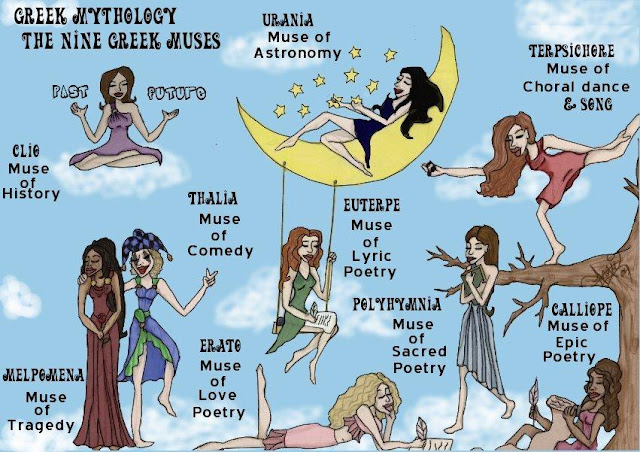My Muse
Who Are the Muses?
The Muses are the personifications of literary arts, music, visual arts, and science.
The Muses inspire creation. Many people believe that the inspiration they need to write literature, a poem, or create an artistic expression is beyond their control, and that creative impulses only come from the Muse they call upon.
The Nine Muses in Greek mythology have been an inspiration to artists since antiquity. Each Muse was assigned expertise in a particular domain of the arts
The Muses' Attributes
- Calliope is the superior Muse. She inspired Homer as he wrote The Iliad and The Odyssey. She accompanied kings and princes to help them impose justice and serenity. Calliope is the protector of poetic works, the rhetoric arts, music, and writing. Calliope is usually depicted with laurels in one hand and two Homeric poems in the other.
- Clio is the protector of history. In ancient Greece, the word for "history" was "Clio" (which is derived from "Kleos," the Greek word for the heroic arts). Depictions of Clio portray her holding a clarion in her right arm and a book in her left hand.
- Erato is the protector of lyrical and love poetry. She holds a lyre, love arrows, and a bow.
- Euterpe is the protector of songs and poetry of death, love, and war. She created several musical instruments and inspires the creation of beautiful music. She is often portrayed with a flute in her hands while her other instruments surround her.
- Melpomene is the protector of the tragedies. She created rhetoric speech and the melodies of tragedy. She is typically depicted holding a tragic theatrical mask.
- Polyhymnia is the protector of divine hymns. She created geometry and grammar. She is usually depicted wearing a veil and looking up to the heavens.
- Terpsichore is the creator and protector of dance. She also created the harp and education. She is usually depicted with a laurel wreath on her head while she holds her harp and dances.
- Thalia is the opposite of Melpomene. She is the protector of comedy, the sciences (including geometry, architecture, and agriculture,) and symposiums. She typically holds a comedic theatrical mask in her depictions.
- Urania is the protector of celestial bodies. She created astronomy, and she bears stars, a celestial sphere, and a compass.
The Muses inspire creation. Many people believe that the inspiration they need to write literature, a poem, or create an artistic expression is beyond their control, and that creative impulses only come from the Muse they call upon.
I discovered this wonderful short art film about an Artist and his Muse. The story goes "An Artist looking for inspiration, cheats on his girlfriend with his Muse and soon finds himself in a world of trouble." It's a very artful, and creative use of the Mythical Muse.
Examples of notable literary muses throughout history.
Beatrice Portinari Dante fell in love with Beatrice in fourteenth-century Florence when both of them were nine years old. Beatrice appears as one of Dante’s guides in the Divine Comedy, leading him to the Beatific Vision. The poet’s love for Beatrice was idealized in the courtly love tradition in which the beloved is viewed as a deity. This is a muse in the old school mode: things hotted up later on.
Fanny Brawne Unrequited love for Fanny Brawne drove John Keats to write some of his best and most intense poetry, including “La Belle Dame Sans Merci.”
Nelly Ternan The story of Charles Dickens and his muse Ellen Ternan has recently dramatized in the movie The Invisible Woman. Ternan was young and beautiful, but also a blank slate onto which Dickens could project his fantasies.
Maude Gonne William Butler Yeats wrote that when he met the red-haired Irish nationalist in 1889 “the troubles in my life began.” Gonne rejected several marriage proposals on the basis that Yeats was neither a Catholic nor a revolutionary. But she lost her power to inspire his art when they finally consummated their relationship nearly 20 years after they first met.
Jeanne Duval Exotic, Haitian-born Duval was the inspiration for much of Charles Baudelaire’s love poetry and was also painted by Edward Manet. Baudelaire attempted suicide while Duval was his mistress, and his mother condemned her as a gold-digger, alcoholic, and all-around woman of ill-repute. Duval also inspired Angela Carter’s short story “Black Venus.”
Zelda Sayre Zelda was a witty, dazzling Southern Belle when F. Scott Fitzgerald first met her, and after their marriage, he used extracts from her diary in his books. She was the model for Nicole Driver in Tender Is the Night, but also inspired Fitzgerald’s wider vision of women in the Jazz Age, and his emphasis on a doomed hedonism. Plagued by mental problems, Sayre wrote her autobiographical novel Save Me the Waltz while in a sanatorium. Since her death in 1948, she has become a feminist icon.
Vivienne Eliot The marriage between T.S Eliot and his wife Vivienne was stormy and unhappy, but initially, she was essential to his poetic output. She typed up his work, and their relationship inspired several sections of his famous poem “The Waste Land.” But she wasn’t fulfilled by her function as muse: her passion was dancing. She died in an asylum in 1947, the year before Eliot won the Nobel Prize for Literature.





Comments
Post a Comment